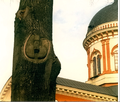- Noul Neamţ Monastery
-
Noul Neamţ Monastery 
Location Chiţcani Country Moldova Denomination Eastern Orthodoxy History Founded 1861 Architecture Status Monastery Noul Neamţ (Romanian; Russian: Ново-Нямецкий, Novo-Nyametsky) is an all-male monastery located in Chiţcani, near Tighina, geographically in Basarabia but controlled by the breakaway Transnistrian authorities. It is also known as Mănastirea Chiţcani (Russian: Kitskani Monastery), and it is the biggest religious complex under the control of Transnistrian authorities.
Contents
Overview
The name (which means "New Neamţ" in English) signifies that the monastery is a successor of the Neamţ Monastery in Romania (medieval Moldavia).
The monastery was founded in 1861, when several monks from the Neamţ monastery left and founded Noul-Neamţ in Chiţcani. The founding of the new monastery was a protest against the measures taken in United Principalities of Romania to confiscate monastery estates and forbid the usage of Slavonic language in worship.[1]
On 16 May 1962 Soviet authorities closed the monastery; the buildings became a hospital.
The monastery church was reopened in 1989, followed in 1991 by the Romanian-language school for Orthodox priests.[2]
Gallery
References
External links
Geography of the Transnistrian conflict Moldovan control Transnistrian control Northern security zoneSouthern security zoneNorthern security zoneSouthern security zone1 belongs to Dubăsari district; 2 belongs to Anenii Noi district; 3 belongs to Căuşeni district; 4 also known as Bender or Tighina; belongs to Municipality of Bender; 5 belongs to the territorial unit TransnistriaCategories:- Christian monasteries in Moldova
- 19th-century Christian monasteries
- 19th-century architecture
- Churches in Moldova
- Places of worship in Moldova
- Seminary stubs
- Christian monastery stubs
- Moldova stubs
Wikimedia Foundation. 2010.




